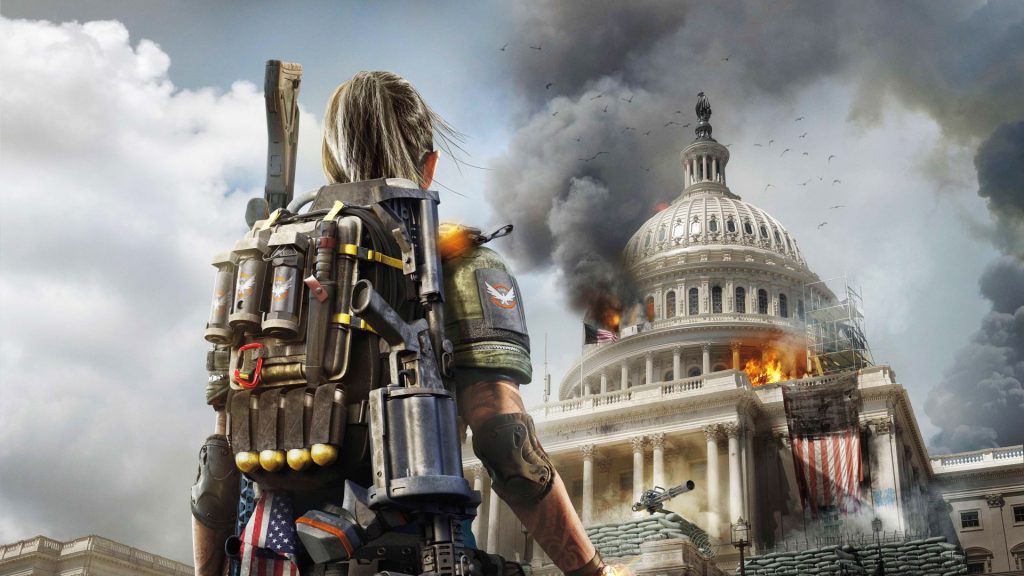
Review copy provided by Ubisoft. Reviewed on PC.
The Division 2 is a lot of fun. After around forty-six hours of chaos, delight, and occasional frustration, there’s no doubt that Ubisoft has found a formula for the loot-based shooter that just works. It doesn’t reinvent the wheel, but it doesn’t need to. The tactical cover-based shooting is well-executed, owing to smart enemy AI, a clever toolset for players, and quality mission design. But it isn’t perfect. The bland narrative won’t win any awards, and the game’s occasional technical issues and bugs frustrate at times. But the polished fundamentals keep drawing me back. The Division 2 is a surprising win for Ubisoft.
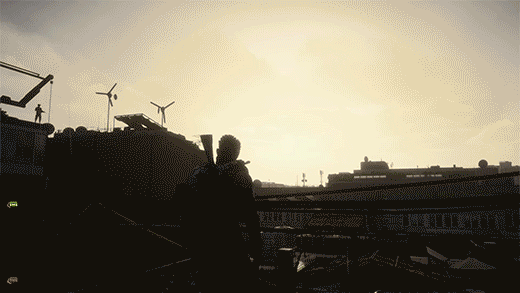
Gameplay
Mechanics
One thing Ubisoft has really nailed with The Division 2 is the dynamic cover system. But more importantly, they’ve actually structured enemy encounters to force you to constantly use it. If you stay behind a piece of cover, you’ll die. They will flank you, they will rush you, and they will flush you out with grenades and special items.
Special skills and abilities are a fun addition to combat, and range from a defensive drone that will deflect enemy fire to a plate you can throw out in front of your enemies that transforms into a flamethrower turret, or the Hive, a small orb that can heal or revive players within its vicinity.
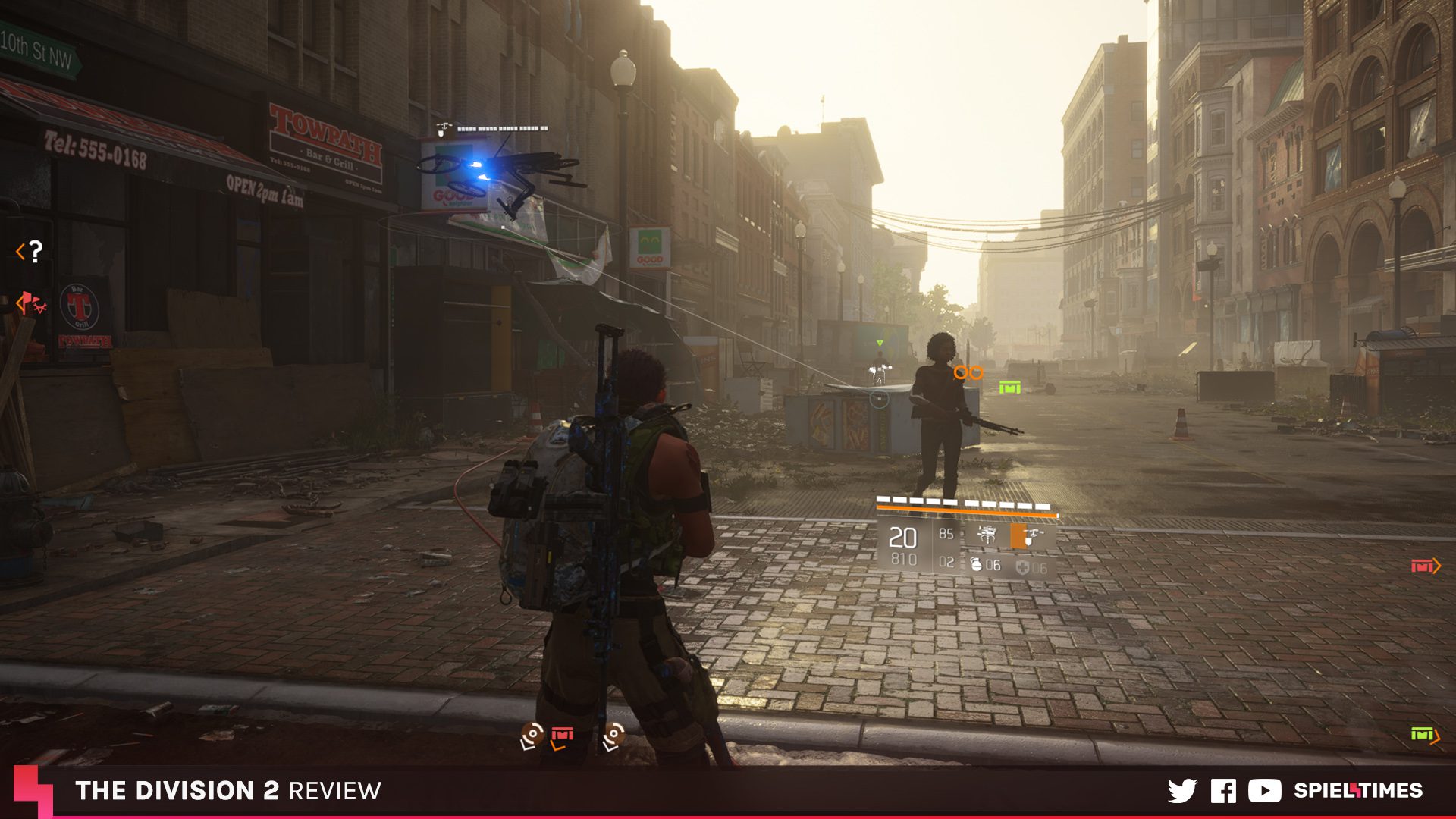
There is a large variety of events and missions within the world, ranging from territory control (which unlocks new fast travel waypoints and gear stashes, but must be maintained with resources found scattered in the world) to preventing roving gangs from committing public executions. Gunplay feels satisfying and weighty, with a huge variety of weapons that all feel properly different enough to harbor new play styles.
The game is constantly feeding you new gear, and that encourages experimentation. If you don’t switch to a newer weapon, you’ll find yourself quickly becoming underpowered and outgunned. The enemy AI is good here, and they are relentless in their pursuit. As a newcomer to The Division franchise, I can’t properly compare this to the first game, but a common complaint there was enemies who seemed more like bullet sponges. And yes, some enemies are highly-armored and can bear clip after clip, most aren’t, and you can kill them with a few rounds. But friendly AI is dreadful at times: why would rescued hostages rush into enemy fire with no armor and not even take cover? At times, friendlies are more like suicidal lemmings.
But this goes two ways: break from cover for a few seconds to rush an enemy and if you’ve miscalculated the number of baddies you’re facing off against you will find yourself overwhelmed very quickly. And you don’t have a lot of health: a few moments of intense enemy fire and you can have your shield depleted or get knocked down. And Ubisoft smartly balances health by making it so that your main source of health, your shields, don’t replenish unless you use one of your limited stock of healing items.
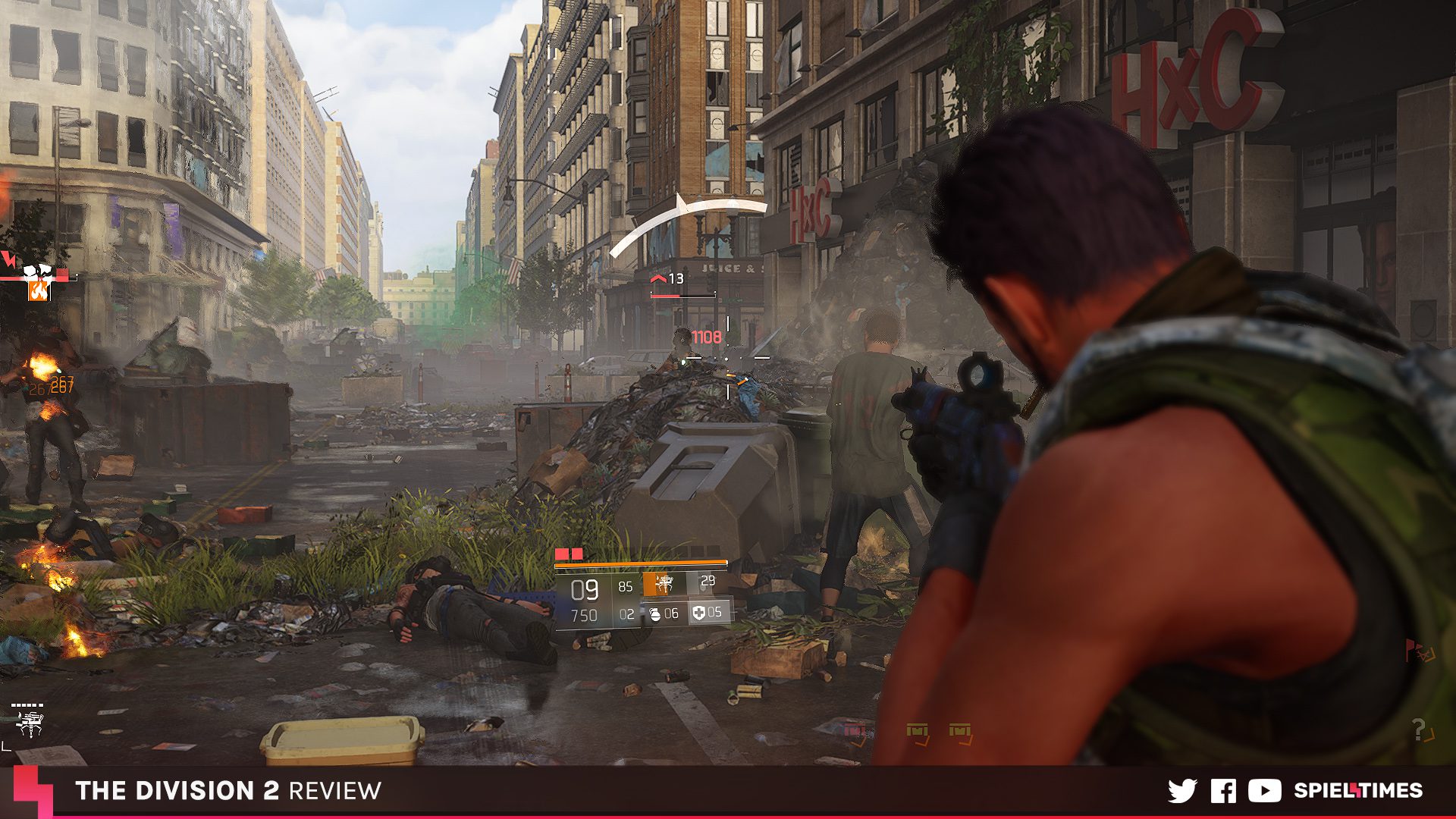
Endgame
Don’t think that reaching the level cap in The Division 2 means it’s all over. After you finish the campaign, the game transforms. Without spoiling the excitement, expect new enemy types, a powerful new clan to take on, and new takes on the main game’s story missions that ramps up the difficulty. My most memorable and extraordinary moments in The Division 2 occurred after I finished the campaign. It’s extraordinary how much work Ubisoft has put into the endgame content of The Division 2. It almost feels like a different game. Expect for every part of your skills to be put to the test in these difficult, spectacular new challenges.
Interface
It’s worth mentioning the game’s UI. Menus are stylish and well-organized, although the game’s many systems sometimes make navigation confusing. The map is excellent. It plots 3D models onto a map of Washington D.C. that clearly lays out the location of your agent and your partners, GPS routes to your destination, and lists of activities. It’s another well-designed map from Ubisoft, that has become one of the best in the business at producing beautiful and functional maps in their open world titles.
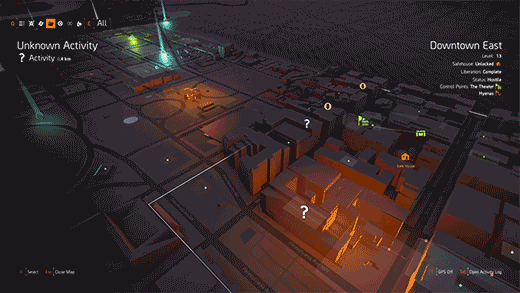
Level Design
The open world leaves something to be desired. Washington D.C.’s landmarks are beautifully rendered, but much of the rest of the city feels generic. It isn’t the most compelling setting, and the game’s encounters would start to feel samey if it didn’t constantly shuttle you away into more designed interiors, which are properly designed cover-based levels with a good variety of indoor environments. Their layouts offer both verticality and versatility in combat and movement options.

And as the game progresses, level design becomes even more interesting. In one particularly impressive mission, you’re shooting through the remains of the American History Museum, searching for the Declaration of Independence. Or in the U.S. Capitol Building, where the House of Representatives has been converted to a makeshift battlefield, replete with barriers for cover and equipment crates. It’s very fun to retreat behind the rostrum of the U.S. House to lob grenades at enemies trying to snipe you from the visitor’s gallery.
Dark Zone and PVP
The most thrilling challenges in The Division 2 come in the Dark Zone. In these tough-as-nails areas, the difficulty is ramped up to 11. Other players can become rogue agents, which opens the opportunity for much better loot and experience rewards. But once you go rogue, you are also a target for other agents, who can take you down in thrilling PvP battles and steal your “contaminated” gear.
That contaminated gear sits at the heart of the Dark Zone’s rewards system. They’re very powerful gear drops that can’t be equipped or used until extracted by helicopter from the Dark Zone. But be careful: the flare used to call an extraction can also summon powerful enemies. And if the drop is attached to the helicopter too soon before it leaves, other agents can steal it. All of these unique challenges add up to a constant feeling of tension and danger when exploring the Dark Zone.
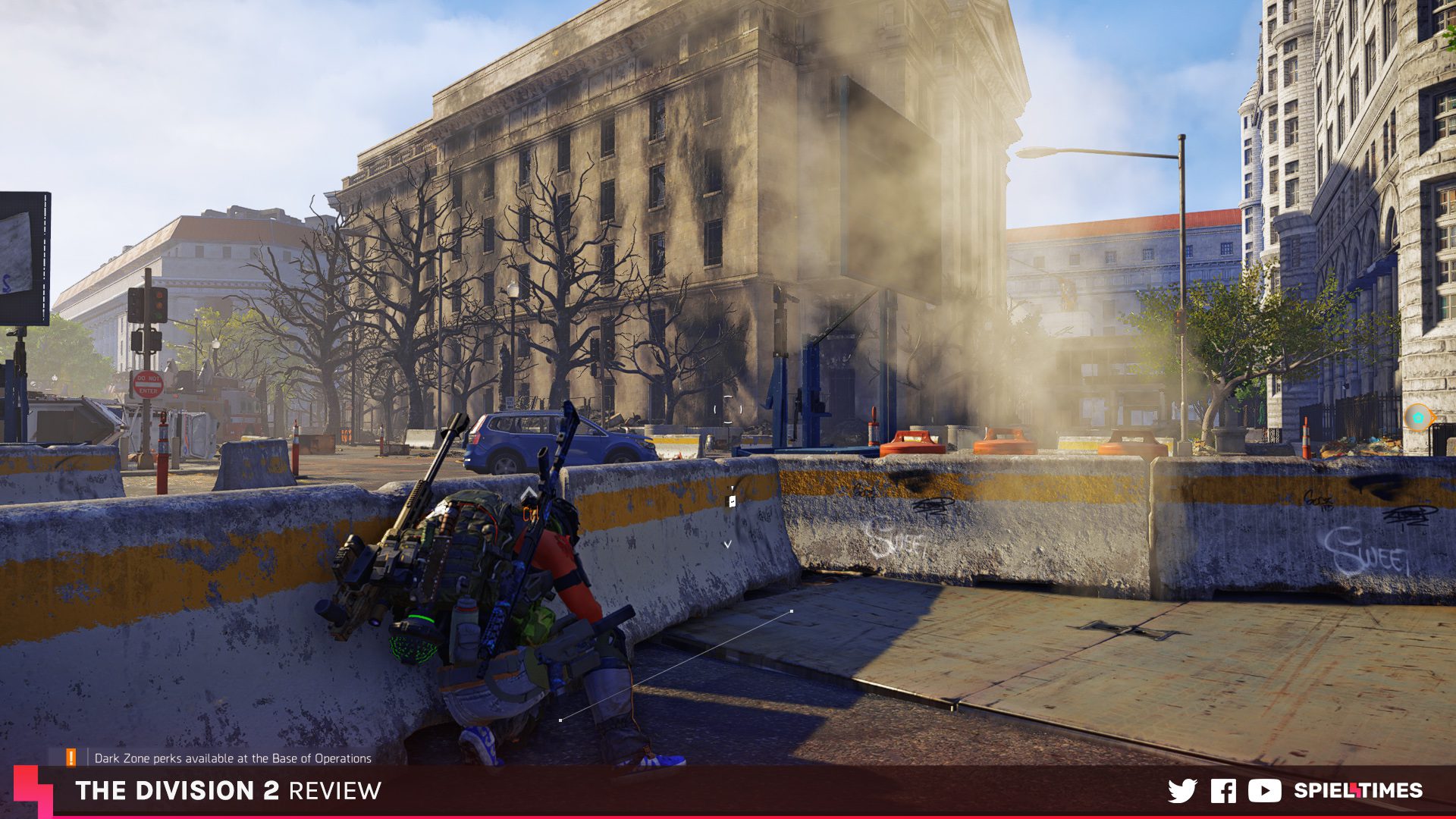
This isn’t the only PvP challenge The Division 2 offers. There are more traditional team-based and deathmatch PvP battles called conflicts. I was surprised by how well The Division 2’s basic mechanics still work when applied to these more traditional battles. One mode has teams facing off in a deathmatch where their number of lives count down from a fixed number every time a team member respawns. When the extra lives expire, the last man standing wins for their team.
The designs for these smaller conflict maps are very good, with intersecting alleyways, main avenues, and ledges and ladders to climb up on top of buildings, where a sniper might be monitoring the street below. It feels more like The Last of Us than Rainbow Six, and close team coordination and precise aim matters more than gadgets and complex tactical plays. Conflicts are surprisingly well-executed and could be an enjoyable multiplayer games in their own rights.
Visuals and Sound
Graphics and Performance
The Division 2 isn’t the most graphically striking game in 2019. Textures sometimes fall flat, and character models and faces can seem stiff with a lack of emotion and animation. On the other hand, the quality of the Snowdrop Engine’s volumetric lighting solution is on full display as light shafts peek through the skyline and give the scene a beautiful glow with a high-quality global illumination. Environments are detailed with lush vegetation and intricate buildings, although shadow quality is strangely jagged and dithered, even on max settings. Another annoyance is the red hue which creeps into the screen when your character loses health.

While the visuals are still good, and it’s worth considering the scale of The Division 2’s open world, there are definitely better-looking games. And games with better performance as it suffers from prolonged frame rate dips and severe stutter at times on PC. Ubisoft has recognized that problem it’s an issue they are addressing in future updates, and that it exists across all platforms, so let’s hope they fix it soon.
Another frustration, are the bugs and glitches. During one important story mission, the final boss disappeared under the map. No one could shoot at him or damage him, and we tried everything. There was no option to restart the mission from the checkpoint, so I had to play the entire mission again from the start.
Sometimes objects will float into the air and spin around randomly. Sometimes NPCs will start levitating. These bugs aren’t common, but they can be extremely annoying in the rare case when they ruin your play session and force you to restart a mission, and the mechanism for reporting them to Ubisoft isn’t as clear as it should be.
Sound
This is very good, although there are a few quibbles. Weapons sound excellent and true-to-life. Snipers let out a bang that gives their recoil the proper feeling of heft, while shotguns blast with a wide snare. Some pistols sound too tinny, but the overall accuracy is stellar. I also want to draw attention to the score, which I’ve only become more impressed by as my time playing The Division 2 went on. Heavy rock drums and chunky guitars blast out with cinematic synth sweeps, and strings provide a feeling of authority and significance to the proceedings.
Ambient pads and throbbing industrial leads provide a great sense of tension in firefights when you’re outnumbered and retreating, and thick walls of guitars cut in as you enter battle. Ubisoft is pros when it comes to weapons and music, but the voice acting is a mixed bag. Most main characters are decent, but the stilted performances from side characters and incidental dialogue leave a lot to be desired.
Story
The story is not The Division 2’s focus nor its forte, and it’s bland and lifeless. Even as a newcomer to The Division franchise, I had no difficulty figuring out what was going on, and the story doesn’t seem to rely much on knowledge of the previous game. In a near-apocalyptic Washington D.C., civilization has sunk into strife dominated by armed clan struggles.
The titular Division is a group of elite agents assisting the continuity U.S. government and allied communities help rebuild and maintain the few settlements that remain insulated from bloodthirsty gangs like the Hyenas, True Sons, and Outcasts. The story never really hits its stride, and it fizzles out with a disappointing ending.

Most of the characters feel lifeless and lack defined personalities. The story fails to deliver any sense of weight and it never reaches a dramatic crescendo. Instead, you’re more likely to forget what exactly you’re fighting, who the main protagonists are, and what motivation you’re supposed to have for engaging in battle with the enemy.
The story is clearly not The Division 2‘s focus: it’s barebones stuff here. That may even be preferable for some fans of the genre, who would rather have a basic story that doesn’t leave much of an impression than an attempt at a cinematic presentation with lengthy cutscenes for a genre that doesn’t really require or ask for it– and I’m looking at you, Anthem.
Conclusion
The Division 2 is a breath of fresh air in a crowded genre. It’s not trying to reinvent the loot shooter, and it doesn’t need to. Instead, Ubisoft has focused on carefully refining and polishing the base elements of gameplay. The excellent shooting and dynamic cover system. The wide variety of enemy types. The diverse and thrilling encounters with effective level design.

When you add it all up, you get a truly special game. It’s not perfect by any stretch of the imagination: they need to work on its technical issues, and the story is barely there and completely forgettable. But its story isn’t what The Division 2 is all about: it’s about exploring this destroyed city with friends and blasting your way through tense, challenging battles.
Expect to get around thirty hours from the main campaign, and dozens more from endgame. Ubisoft has made a game that’s jam-packed with content, and they should be rewarded for it: The Division 2 is worth playing for anyone even remotely interested in the genre.
